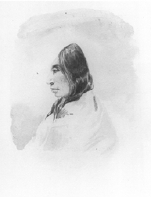Sex at Dawn: The Prehistoric Origins of Modern Sexuality (21 page)
Read Sex at Dawn: The Prehistoric Origins of Modern Sexuality Online
Authors: Christopher Ryan,Cacilda Jethá
Tags: #Non-Fiction, #Sociology, #Psychology, #Science, #Social Science; Science; Psychology & Psychiatry, #History

“Marriage,” “mating,” and “love” are socially constructed phenomena that have little or no transferable meaning outside any given culture. The examples we’ve noted of rampant ritualized group sex, mate-swapping, unrestrained casual affairs, and socially sanctioned sequential sex were all reported
in
cultures
that
anthropologists
insist
are
monogamous simply because they’ve determined that something they call “marriage” takes place there. No wonder so many insist that marriage, monogamy, and the nuclear family are human universals. With such all-encompassing interpretations of the concepts, even the prairie vole, who
“sleeps with anyone,” would qualify.
* Most famously in Nora Ephron’s film
Heartburn.
CHAPTER TEN
Jealousy:
A
Beginner’s
Guide
to
Coveting
Thy
Neighbor’s Spouse
[Once] marriage … becomes common, jealousy will lead to
the inculcation of female virtue; and this, being honoured,
will tend to spread to the unmarried females. How slowly it
spreads to the male sex, we see at the present day.
CHARLES DARWIN1
In a traditional Canela marriage ceremony, the bride and
groom lie down on a mat, arms under each other’s heads,
legs entwined. The brother of each partner’s mother then
comes forward. He admonishes the bride and her new
husband to stay together until the last child is grown,
specifically reminding them not be jealous of each other’s
lovers.
SARAH BLAFFER HRDY2
A printer’s error in 1631 resulted in Bibles that proclaimed,
“Thou shalt commit adultery.”3 Though not a biblical injunction, a common thread running through many of our examples of S.E.Ex. (Socio-Erotic Exchanges, if you’ve forgotten) is the explicit prohibition against relations with one’s habitual partner(s), sometimes even under threat of death. Why would that be?
Since these rituals have developed in unrelated cultures throughout the world, they probably serve important functions. Internal conflict represented an existential threat to profoundly interdependent groups like those in which our ancestors lived for thousands of generations. Ritualized, socially sanctioned, sometimes even obligatory S.E.Ex.
reduced disruptions caused by jealousy and possessiveness while blurring paternity. It’s not surprising that small-scale societies highly dependent upon trust between individuals, generosity, and cooperation evolve and promote ways of enhancing these qualities while discouraging behavior and beliefs that would threaten group harmony and survival for group members.
It bears repeating that we are not attributing any particular nobility or, for that matter, ignobility to foragers. Some behaviors that seem normal to contemporary people (and which are therefore readily assumed to be universal) would quickly destroy many small-scale foraging societies, rendering them dysfunctional. Unrestrained self-interest, in particular, whether expressed as food-hoarding or excessive sexual possessiveness, is a direct threat to group cohesion and is therefore considered shameful and ridiculous.

Photo:
Christopher
White,
www.christopherwhitephotography.com
Is there any doubt that societies can reshape such impulses?
Right now, girls’ necks are being elongated ring by brass ring in parts of Thailand and Burma to make them more appealing to men. Clitorises are being cut away and labia sewn together in villages all over North Africa to dampen female desire, while in glamorous California, reduction labioplasty and other cosmetic vaginal surgeries have recently become a booming business. Elsewhere, the penises of boys are being circumcised or split open in ritualistic subincision. You get the point.

A few Native American tribes of the upper plains had an agreed-upon sense of beauty that led them to strap small planks of wood to their infants’ still-pliable foreheads.4 As the child grew, the straps would be tightened, as an orthodontist realigns a bite, bit by bit. It’s unclear how much brain damage, if any, resulted from this practice, but the otherworldly conical heads that resulted scared the bejesus out of neighboring tribes and white fur trappers in the area.
Field sketch by Paul Kane5
And that may well have been the point, if you will. If their otherworldly appearance gave them a protective advantage by scaring potential enemies, it’s not hard to see how such a fashion statement could have evolved. From savoring saliva beer or cow blood milkshakes to wearing socks with sandals, there is little doubt that people are willing to think, feel, wear, do, and believe pretty much anything if their society assures them it’s
normal.
Social forces that convince people to stretch their necks beyond the breaking point, schmush the heads of their infants, or sell their daughters into sacred prostitution are quite capable of reshaping or neutralizing sexual jealousy by rendering it silly and ridiculous. By rendering it
abnormal.
The evolutionary explanation for male sexual jealousy, as we’ve seen, pivots on the genetic calculus underlying paternity certainty. But if it’s a question of genes, a man should be far less concerned about his wife having sex with his brothers—who share half his genes—than with unrelated males. Gentlemen, would
you
be far less upset to find your wife in bed with your brother than with total a stranger?
Ladies, would you prefer your husband have an affair with your sister? Didn’t think so.6
Zero-Sum Sex
We mentioned David Buss in our discussion of mixed mating strategies earlier, but most of his work concerns the study of jealousy. Buss doesn’t buy the notion of sharing food or mates, conceptualizing both in terms of scarcity: “If there is not enough food to feed all members of a group,” he writes,
“then some survive while others perish.” Similarly, “If two women desire the same man … one woman’s success in attracting him is the other woman’s loss.” Buss has little doubt that evolution is “a zero-sum game, with the victors winning at the expense of the losers.”7
Far too often, the debate over the nature of human sexuality seems
like
a
proxy
war
between
antagonistic
politico-economic philosophies. Defenders of the standard narrative see Cain’s gain as Abel’s loss, period. “That’s just how life is, kid,” they’ll tell you. “It’s human nature.
Self-interest makes the world go round, pull yourself up by your bootstraps, it’s a dog-eat-dog world and always has been.”
This free-market vision of human mating hinges on the assumption that sexual monogamy is intrinsic to human nature. Absent monogamy (individual male “ownership” of female reproductive capacity), the I-win-you-lose dynamic collapses. As we outlined above, Buss and his colleagues get around the many glaring flaws in the theory (our extravagant sexual capacity, ubiquitous adultery in
all
cultures, rampant promiscuity in
both
our closest primate relatives, the absence of
any
monogamous primate living in large social groups) with pretzel logic and special pleading about
Homo sapiens’
internally
conflicted,
self-defeating
“mixed
mating
strategies.” Twist and stretch.
Buss and his colleagues have conducted scores of cross-cultural studies designed to confirm that men and women experience jealousy differently from each other, in consistent gender-specific ways. These researchers claim to have confirmed two important assumptions underlying the standard narrative: that men are universally worried about paternity certainty (hence, his mate’s
sexual
fidelity is his main concern), while women are universally concerned with access to men’s resources (so a woman will feel more threatened by any
emotional intimacy
that might inspire him to leave her for another woman). These gender-specific manifestations of sexual jealousy would appear to strongly support the standard narrative.
In a study typical of this research, Buss and his colleagues asked 1,122 people to imagine their partner becoming interested in someone else. They asked, “What would upset or distress you more: (a) imagining your partner forming a deep emotional (but not sexual) relationship with that person, or (b) imagining your partner enjoying a sexual (but not emotional) relationship with that person?” In studies like this conducted on college campuses around the United States and Europe, Buss and his colleagues consistently got more-or-less the same results. They found that men and women differed by roughly 35 percent in their responses, seeming to confirm their hypothesis. “Women continued to express greater upset about a partner’s emotional infidelity,” Buss writes, “even if it did not involve sex. Men continued to show more upset than women about a partner’s sexual infidelity, even if it did not involve emotional involvement.”8
But despite the apparent cross-cultural breadth of this research, it lacks methodological depth. Buss and his colleagues succumb to the same temptation that weakens so much sexuality research: reliance on a subject population more convenient than representative. Almost all the participants in these studies were university students. We understand that undergraduate students are low-hanging research fruit—easy for graduate students to locate and motivate (by offering partial course-credit for filling out a questionnaire, for example), but
this does not make them valid
representatives of human sexuality.
Far from it. Even in supposedly liberal Western cultures, college-age people are in the early stages of their socio-sexual development with little, if any, experience to draw on when considering questions about one-night stands, long-term mate preferences, or their ideal number of lifetime sexual partners—all questions explored in Buss’s research.
But Buss is not alone in this distorting focus on undergrads.
The majority of research on sexuality is based upon the responses of eighteen- to twenty-two-year-old American university students. While one could make a case that a twenty-year-old guy is more or less like a turbocharged fifty-year-old, few would argue that a twenty-year-old woman has much in common with a woman three decades older in terms of her sexuality. Most would agree that a woman’s sexuality changes considerably throughout adulthood.
Another problem with using college students in the sort of multicultural study Buss conducts concerns class distinctions.
In underdeveloped countries, university students are likely to be from the upper classes. A wealthy Angolan student may have a lot more in common with a Portuguese undergrad than with someone his or her own age living in the slums of Luanda. Our own field research in Africa suggests that sexual beliefs and behavior differ greatly among social classes and subcultures there—as they do in other parts of the world.9
Beyond the distorting effects of age and class, Buss and his colleagues skip over the crucial fact that every one of their subjects lives in post-agricultural societies characterized by private property, political hierarchies, globalized television, and so on. How can we expect to identify “human universals” without including at least a few foragers, whose thoughts and behaviors have not been shaped by the effects of modern life and whose perspective represents the vast majority of our species’ experience? As we’ve established, plenty of research on foragers demonstrates important similarities among unrelated
societies
and
dramatic
differences
from
post-agricultural norms. Swedes and upper-class Nigerians may see themselves as different from one another, but from a forager’s perspective they would seem similar in many ways.
Granted, it is no easy matter to airdrop questionnaires and #2
pencils to foragers in the Upper Amazon
(The Grad Students
Must Be Crazy).
Still, the difficulty or impossibility of including their perspective does nothing to lessen its vital importance to the integrity of this sort of research. This broad yet shallow research paradigm is like claiming to have uncovered “universal fish truths” after conducting studies in rivers around the world. What about the fish in lakes? Ponds?